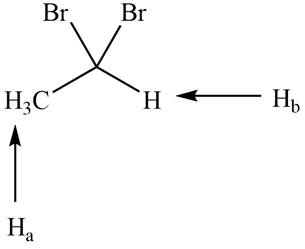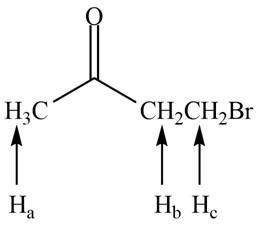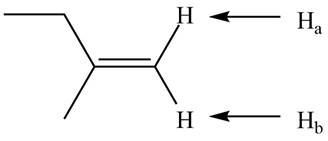
Concept explainers
(a)
Interpretation: The number of peaks for each indicated proton is to be predicted.
Concept introduction: The number of NMR signal in a compound is equal to the number of chemically non-equivalent protons present in that compound. Protons which are present in the same chemical environment that is between the same group of atoms are known as chemically equivalent protons and in
Answer to Problem 14.14P
The given compound shows two signals in
Explanation of Solution
The number of signals in each compound is equal to the number of hydrogen atoms present in a different chemical environment. The given compound is
It has two different types of non-equivalent protons shown in red color. Therefore, it gives two signals in
The given compound shows two signals in
(b)
Interpretation: The number of peaks for each indicated proton is to be predicted.
Concept introduction: The number of NMR signal in a compound is equal to the number of chemically non-equivalent protons present in that compound. Protons which are present in the same chemical environment that is between the same group of atoms are known as chemically equivalent protons and in
Answer to Problem 14.14P
The given compound shows two signals in
Explanation of Solution
The given compound is shown below.

Figure 1
It has two non-equivalent protons. Therefore, it gives two signals in
The signal
The given compound shows two signals in
(c)
Interpretation: The number of peaks for each indicated proton is to be predicted.
Concept introduction: The number of NMR signal in a compound is equal to the number of chemically non-equivalent protons present in that compound. Protons which are present in the same chemical environment that is between the same group of atoms are known as chemically equivalent protons and in
Answer to Problem 14.14P
The given compound shows three signals in
Explanation of Solution
The given compound is shown below.

Figure 2
It has three non-equivalent protons. Therefore, it gives three signals in
The signal
The given compound shows three signals in
(d)
Interpretation: The number of peaks for each indicated proton is to be predicted.
Concept introduction: The number of NMR signal in a compound is equal to the number of chemically non-equivalent protons present in that compound. Protons which are present in the same chemical environment that is between the same group of atoms are known as chemically equivalent protons and in
Answer to Problem 14.14P
The given compound shows two signals in
Explanation of Solution
The given compound is shown below.

Figure 3
It has two non-equivalent protons. Therefore, it gives two signals in
The signal
The given compound shows two signals in
(e)
Interpretation: The number of peaks for each indicated proton is to be predicted.
Concept introduction: The number of NMR signal in a compound is equal to the number of chemically non-equivalent protons present in that compound. Protons which are present in the same chemical environment that is between the same group of atoms are known as chemically equivalent protons and in
Answer to Problem 14.14P
The given compound shows two signals in
Explanation of Solution
The given compound is shown below.

Figure 4
It has two non-equivalent protons. Therefore, it gives two signals in
The signal
The given compound shows two signals in
(f)
Interpretation: The number of peaks for each indicated proton is to be predicted.
Concept introduction: The number of NMR signal in a compound is equal to the number of chemically non-equivalent protons present in that compound. Protons which are present in the same chemical environment that is between the same group of atoms are known as chemically equivalent protons and in
Answer to Problem 14.14P
The indicated protons
Explanation of Solution
The given compound is shown below.

Figure 5
It has three non-equivalent protons. Therefore, it gives three signals in
The signal
Hence, the indicated protons which are shown in red color shows doublet and triplet peaks.
The indicated protons
Want to see more full solutions like this?
Chapter 14 Solutions
ORGANIC CHEMISTRY SOLUTIONS MANUAL
- a) which bond is present in alcohols but not alkanes? b) is this band strong or weak (in terms of spectra)? c) what is different about C=O and O-H bonds compared with C=C or C≡C bonds that show weaker signals?arrow_forwardcan they distinguish by HNMR spectrum ? and if yes How many peak they show in HNMR spectrum ?if not , why ?arrow_forwardInto how many NMR peaks would the circled Hydrogen be split?arrow_forward
- Spectrum 2. Match the correct compound to the given NMR spectra. On the spectrum, match the signals on the NMR with the protons of the structure (use arrows to point or use letter or number designations).arrow_forwardAssign all resonances in both spectra. (The solvent used for this NMR is acetone)arrow_forwardhow nmr work?arrow_forward
 Organic Chemistry: A Guided InquiryChemistryISBN:9780618974122Author:Andrei StraumanisPublisher:Cengage Learning
Organic Chemistry: A Guided InquiryChemistryISBN:9780618974122Author:Andrei StraumanisPublisher:Cengage Learning Physical ChemistryChemistryISBN:9781133958437Author:Ball, David W. (david Warren), BAER, TomasPublisher:Wadsworth Cengage Learning,
Physical ChemistryChemistryISBN:9781133958437Author:Ball, David W. (david Warren), BAER, TomasPublisher:Wadsworth Cengage Learning,

